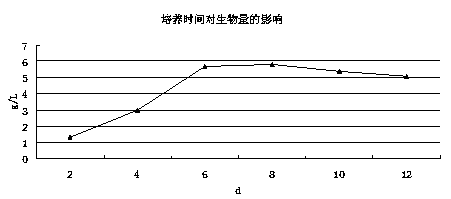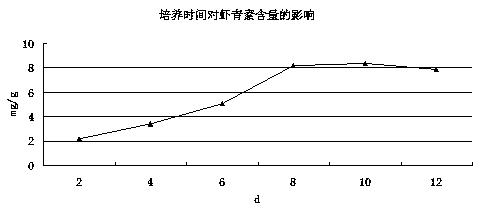Method for producing astaxanthin by using starch waste water
A technology for starch wastewater and astaxanthin, applied in the biological field, can solve the problems of difficult starch wastewater treatment, low astaxanthin yield and the like
- Summary
- Abstract
- Description
- Claims
- Application Information
AI Technical Summary
Problems solved by technology
Method used
Image
Examples
Example Embodiment
[0034] Example 1
[0035] A method utilizing starch waste water to produce astaxanthin, comprising the steps of:
[0036] Step 1) Pretreatment of starch wastewater: starch wastewater first enters the sedimentation tank for 24 hours, and then enters the acid-base adjustment tank to adjust the pH to 7.0;
[0037] Step 2) Preparation of mixed bacterial solution: Inoculate Bacillus amyloliquefaciens on LB solid medium for culture to obtain a single colony; pick a single colony and inoculate it on LB liquid medium for expansion culture, and obtain a concentration of 5×10 8 Bacillus amyloliquefaciens culture fluid of cfu / ml;
[0038] Inoculate Lactobacillus plantarum on MRS solid medium for culture to obtain a single colony, and then insert it into MRS liquid medium for expanded culture, and cultivate to a concentration of 5×10 8 Lactobacillus plantarum culture solution of cfu / ml;
[0039] Streak culture of Rhodopseudomonas palustris on the LB plate to obtain a single colony; pi
Example Embodiment
[0043] Example 2
[0044] A method utilizing starch waste water to produce astaxanthin, comprising the steps of:
[0045] Step 1) Pretreatment of starch wastewater: starch wastewater first enters the sedimentation tank for 12 hours, and then enters the acid-base adjustment tank to adjust the pH to 7.5;
[0046] Step 2) Preparation of mixed bacterial solution: Inoculate Bacillus amyloliquefaciens on LB solid medium for culture to obtain a single colony; pick a single colony and inoculate it on LB liquid medium for expansion culture, and obtain a concentration of 7×10 8 Bacillus amyloliquefaciens culture fluid of cfu / ml;
[0047] Inoculate Lactobacillus plantarum on MRS solid medium for culture to obtain a single colony, and then insert it into MRS liquid medium for expanded culture, and cultivate to a concentration of 3×10 8 Lactobacillus plantarum culture solution of cfu / ml;
[0048] Streak culture of Rhodopseudomonas palustris on LB plates to obtain a single colony; pick
Example Embodiment
[0052] Example 3
[0053] The treatment effect of composite bacterial liquid of the present invention to starch wastewater:
[0054] Taking the composite bacterial solution of Example 1 as an example, the control group 1 is two bacterial strains of Bacillus amyloliquefaciens and Lactobacillus plantarum, and the rest are the same as in Example 1; The control group 2 is Lactobacillus plantarum and Rhodopseudomonas palustris, and the rest are the same Embodiment 1; Control group 3 is Bacillus amyloliquefaciens and Rhodopseudomonas palustris, all the other are the same as embodiment 1. The specific results are shown in Table 1:
[0055] Table 1
[0056]
[0057] As shown in Table 1, after microbial treatment, the pollutants in the wastewater are greatly reduced, which is suitable for cultivating Haematococcus pluvialis.
PUM
 Login to view more
Login to view more Abstract
Description
Claims
Application Information
 Login to view more
Login to view more - R&D Engineer
- R&D Manager
- IP Professional
- Industry Leading Data Capabilities
- Powerful AI technology
- Patent DNA Extraction
Browse by: Latest US Patents, China's latest patents, Technical Efficacy Thesaurus, Application Domain, Technology Topic.
© 2024 PatSnap. All rights reserved.Legal|Privacy policy|Modern Slavery Act Transparency Statement|Sitemap


